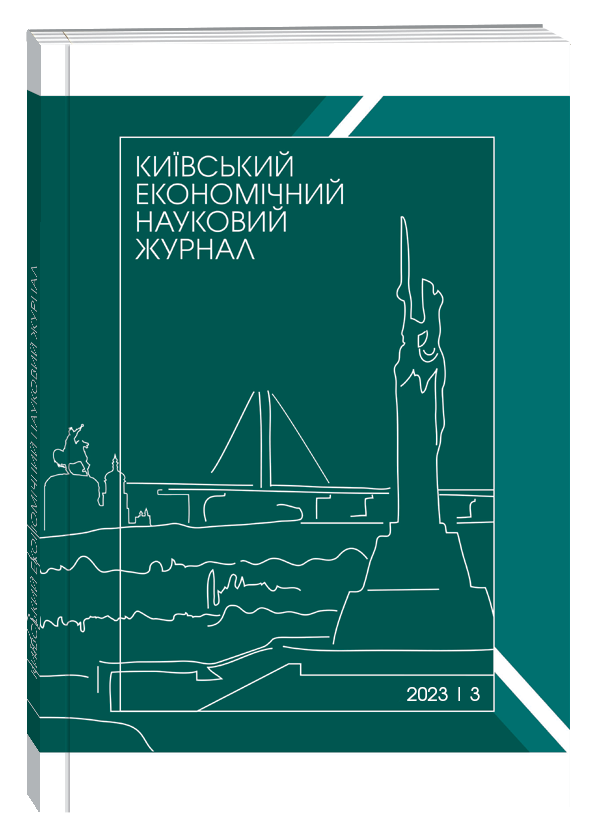MODELS OF ARTIFICIAL INTELLIGENCE IN INVESTMENT ACTIVITY AT FINANCIAL MARKETS
Abstract
Objective. One of the most important directions of improvement of methodological support of investment activity is automation of the process of making investment decisions. The concept of automation is quite widely covered in the scientific literature as a process of processing data using software and hardware. By the majority of scientists, the concept of "automated system" is interpreted as a system consisting of the personnel and the complex of means of automation of its activities and implements the information technology of the implementation of the established functions. The main goal of creating an intellectual system is divided into two sub-goals, such as subject matter analysis and choice of software solution. Methods. We are using the method of artificial intelligence (AI) for our tasks. AI in finances can analyze large datasets to provide insights into market trends, investor sentiment, and macroeconomic factors, helping traders and investors make informed decisions. This method will optimize investment portfolios by continuously analyzing market data and adjusting asset allocations to meet specific financial goals and risk tolerance. Results. Modern information systems work with a set of business processes that covers the main functions of production: production, planning and inventory management (MRP). Development of the concept of enterprise resource planning leads to the emergence of a production management system - Enterprise Resource Planning (ERP); the successful implementation of the ERP system allows for enterprise to reduce the volume of inventory, reduce the time to market new products, increase profits. Scientific novelty. At present, the application of the methodology of ERP is becoming more widespread, it provides an opportunity to optimize all internal operations: acceptance of orders, planning and management of production, procurement, direct production, delivery. The effectiveness of using ERP systems in industrial enterprises is due to the fact that this approach considers the implementation of major production operations as a continuous process, governed by a set of rules and procedures. As a result, all activities carried out within the chain of product creation become automated, and information on operations, cost and profitability of products, results of units work becomes available in real time. Practical significance. Nodays, as we confirm in our reserches, there is no realization of algorithms of artificial intelligence in a single system. The financial manager cannot make all operation for analisys and decision making in one interface. The author proposes a set of software tools that can help the financial manager to understand the situation at the financial market, make the necessary calculations, form a budget and solve the issue of investment.
References
Степаненко О.П. Інтелектуальні системи підтримки управління діяльністю організації. Культура народов Причерноморья. 2008. № 140. С. 119–122.
Берко А.Ю., Явлінський О.М. Інтелектуальна система підтримки прийняття рішень при управлінні неприбутковими організаціями. Вісник Національного університету «Львівська політехніка». Інформаційні системи та мережі. 2009. № 653. С. 12–23.
Ситник В.Ф. Системи підтримки прийняття рішень : навч. посібник. Київ : КНЕУ, 2004. 614 с.
Кошелєва В.С. Комп’ютерні технології як засіб формування проектувальних умінь розробки бізнес-планів у майбутніх інженерів-педагогів економічного профілю. Проблеми інженерно-педагогічної освіти. 2007. № 16. С. 113–126.
Лагодієнко В.В. Щодо комп’ютеризації сільськогосподарського бізнес-планування. Вісник аграрної науки Причорномор’я. 2006. Випуск 1. С. 33–39.
Балацький О.Ф., Теліженко О.М., Соколов М.О. Управління інвестиціями : навч. посібник для студ. вищих навч. закл. Суми : Університетська книга, 2004. 231 с.
Вітлінський В., Матвійчук А. Зміна парадигми в сучасній теорії економіко-математичного моделювання. Економіка України. 2007. № 11. С. 35–43.
Aseem Brahma, Mithun Chakraborty, Sanmay Das, Allen Lavoie, and Malik Magdon-Ismail. A Bayesian market maker. In Proceedings of the ACM Conference on Electronic Commerce. 2012. Р. 215–232.
Brock W., Lakonishok J., and LeBaron B. Simple technical trading rules and the stochastic properties of stock returns. The Journal of Finance. 1992. No. 47(5). P. 1731–1764.
Stepanenko O.P. (2008) Intelektualni systemy pidtymky upravlinnya diyalnistyu organizacii [Intellegent systems of support management of the organization]. Culture of peoples of Black Sea region, no. 140, pp. 119–122.
Berko A.Y., Yavlinskiy O.M. (2009) Intelektualna systema pidtrymky priynyatya rishen pry upravlinni neprybutkovymy organizaciyamy [Intellegent system of decision support in management of non-profit organizations]. Bulletin of Lviv Polytechnic National University. Information systems and networks, no. 653, pp. 12–23.
Sytnyk V.F. (2004) Systemy pidtrymky priynyatya rishen [Decision support systems]. Kyiv: KNEU, 614 p.
Kosheleva V. S. (2007) Kompyuterni tehnologii yak zasib formuvanya proektuvalnyh umin rozrobky biznes-planiv u maybutnih injeneriv-pedagogiv ekonomichnogo profilyu [Computer technologies like a tool of forming of projecting skills of business plans creating for future engineers at economic profile]. Problems of engineer-pedagogic education, no. 16, pp. 113–126.
Lagodienko V.V. (2006) Schodo kompyuterizacii silskogospodarskogo biznes-planuvanya [In case of agricultural business-planning]. Bulletin of Agricultural Science of Black Sea Region, no. 1, pp. 33–39.
Balackiy O.F., Telijenko O.M., Sokolov M.O. (2004) Upravlinya investiciyami [Investment mamagement]. Sumy: University book, 231 p.
Vitlinskiy V., Matviychuk A. (2007) Zmina paradigmy v suchasniy teorii ekonomiko-matematychnogo modelyuvanya [Paradigm change in modern theory of economic-mathematic modelling]. Ukranian Economics, no. 11, pp. 35–43.
Aseem Brahma, Mithun Chakraborty, Sanmay Das, Allen Lavoie, and Malik Magdon-Ismail (2012) A Bayesian market maker. In Proceedings of the ACM Conference on Electronic Commerce. Pp. 215–232.
Brock W., Lakonishok J., and LeBaron B. (1992) Simple technical trading rules and the stochastic properties of stock returns. The Journal of Finance, no. 47(5), pp. 1731–1764.


